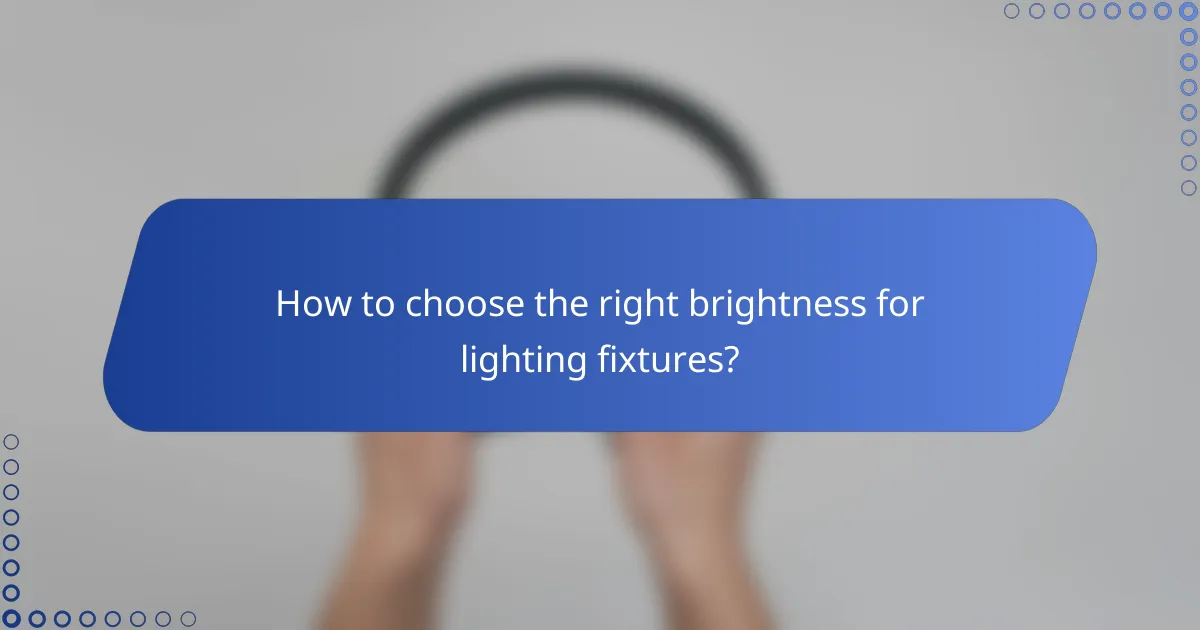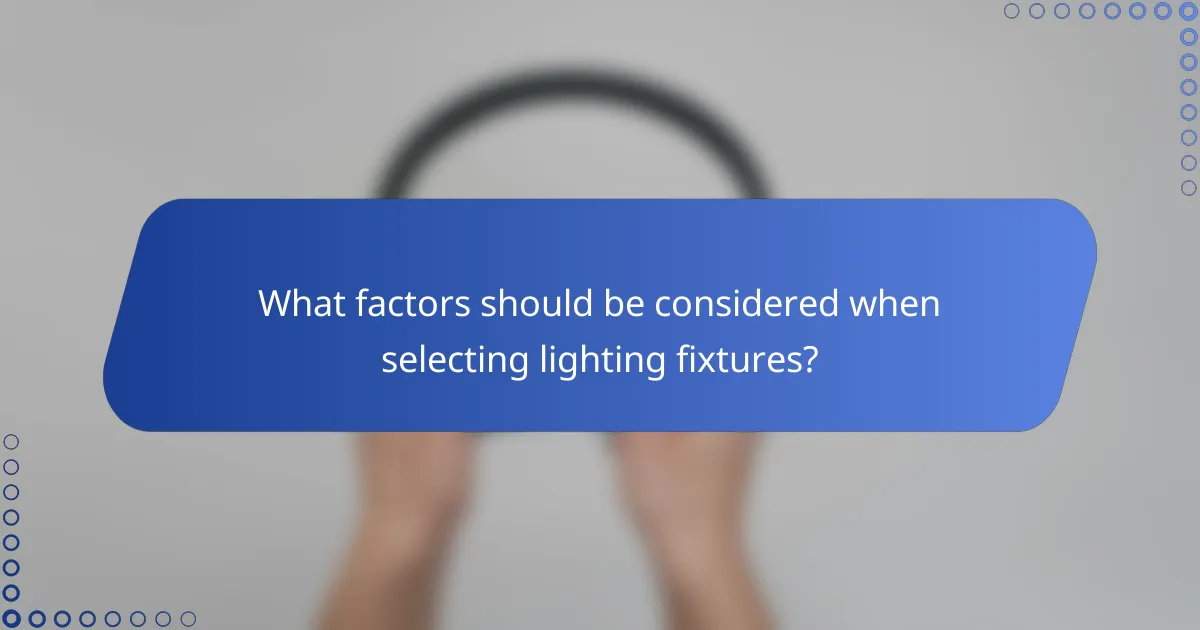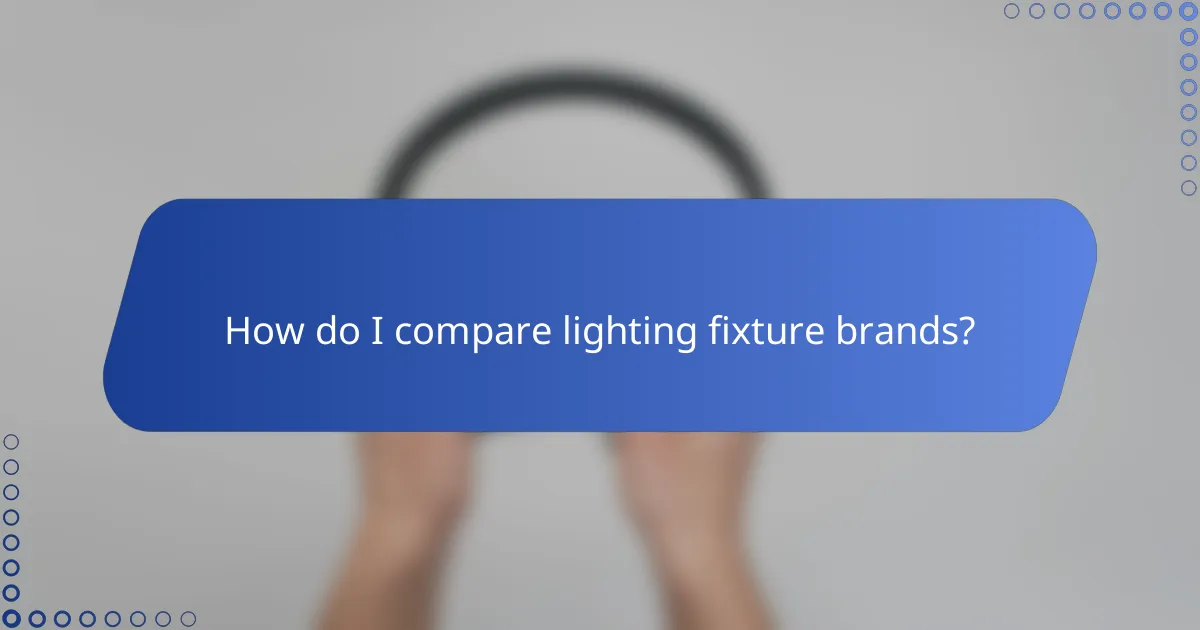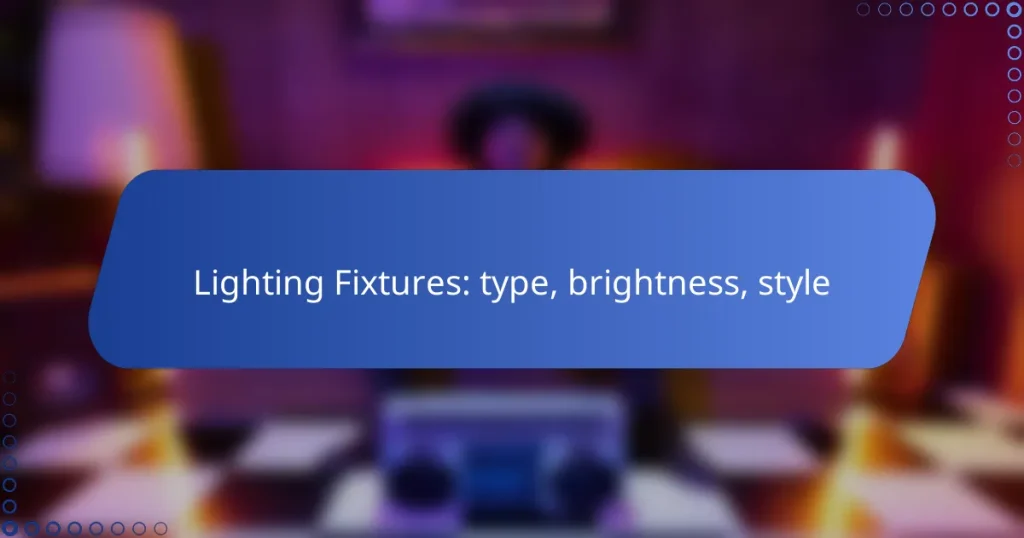Lighting fixtures play a crucial role in enhancing both the functionality and aesthetic appeal of a space. With a variety of types available, such as ceiling lights, wall sconces, and chandeliers, each serves distinct purposes while contributing to the overall decor. Selecting the appropriate brightness is essential for comfort and utility, and understanding styles like modern, industrial, and vintage can help create a cohesive interior design.

What types of lighting fixtures are available in the UK?
In the UK, various types of lighting fixtures cater to different needs and aesthetics, including ceiling lights, wall sconces, table lamps, floor lamps, and chandeliers. Each type serves specific purposes, from general illumination to decorative accents.
Ceiling lights
Ceiling lights are a primary source of illumination in most rooms, providing broad coverage. They come in various styles, including flush mounts, pendant lights, and recessed lighting, allowing for flexibility in design and brightness.
When selecting ceiling lights, consider the room size and ceiling height. For example, pendant lights work well in spaces with higher ceilings, while flush mounts are ideal for lower ceilings.
Wall sconces
Wall sconces are versatile fixtures that add both light and style to a space. They can be used for ambient lighting, accent lighting, or task lighting, depending on their placement and design.
Choose wall sconces that complement your room’s decor. For instance, modern sconces can enhance a contemporary space, while vintage styles may suit a more traditional setting.
Table lamps
Table lamps provide localized lighting and are often used for reading or creating a cozy atmosphere. They come in various designs, sizes, and brightness levels, making them suitable for different surfaces like desks, side tables, or nightstands.
When selecting a table lamp, consider the lamp’s height and shade style to ensure it fits well with your furniture and provides adequate light without being too harsh.
Floor lamps
Floor lamps are freestanding fixtures that offer flexibility in lighting arrangements. They can serve as accent pieces or provide general illumination in larger rooms.
Look for floor lamps with adjustable heights or multiple light settings to customize the lighting according to your needs. They are particularly useful in living rooms or reading nooks.
Chandeliers
Chandeliers are decorative lighting fixtures that hang from the ceiling and are often used in dining rooms or entryways. They come in various styles, from ornate crystal designs to minimalist modern options.
When choosing a chandelier, consider the room’s size and ceiling height to ensure it is proportionate. A well-placed chandelier can serve as a stunning focal point while providing ample light.

How to choose the right brightness for lighting fixtures?
Choosing the right brightness for lighting fixtures involves understanding lumens, the size of the room, and the specific tasks performed in that space. Proper brightness enhances functionality and comfort while reducing eye strain.
Consider lumens for brightness
Lumens measure the total amount of visible light emitted by a source. For general lighting, aim for around 100 to 200 lumens per square meter, depending on the room’s purpose. For example, living rooms may require 150-300 lumens, while kitchens often need 300-500 lumens for effective task lighting.
When selecting bulbs, check the packaging for lumen ratings to ensure you achieve the desired brightness. Higher lumens indicate brighter light, so balance your choice with the fixture’s style and intended use.
Match brightness to room size
The size of the room significantly influences the required brightness. Smaller rooms can often function well with lower lumens, while larger spaces may need more intense lighting to ensure even illumination. For instance, a small bedroom might only need about 1,500 lumens, while a large living area could require upwards of 3,000 lumens.
Consider using multiple fixtures or layers of light to distribute brightness evenly across larger areas. This approach helps avoid harsh shadows and creates a more inviting atmosphere.
Adjust brightness for tasks
Different tasks require varying levels of brightness. For example, reading or detailed work may need brighter light, around 500-800 lumens, while ambient lighting for relaxation can be softer, around 200-300 lumens. Tailoring brightness to specific activities enhances functionality and comfort.
Utilize dimmers or adjustable fixtures to modify brightness as needed. This flexibility allows you to create the right environment for different tasks, from focused work to casual gatherings.

What styles of lighting fixtures are popular in the UK?
In the UK, popular lighting fixture styles include modern, industrial, vintage, and minimalist designs. Each style offers unique aesthetics and functionality, catering to various tastes and interior themes.
Modern lighting
Modern lighting fixtures emphasize sleek lines and innovative designs, often incorporating materials like metal and glass. They typically feature energy-efficient LED bulbs, providing bright illumination while reducing electricity costs.
When selecting modern lighting, consider fixtures that complement your existing decor. Options like pendant lights and wall sconces can enhance both functionality and style in contemporary spaces.
Industrial style
Industrial lighting fixtures draw inspiration from warehouses and factories, showcasing raw materials such as exposed bulbs, metal finishes, and rustic elements. This style often includes pendant lights and floor lamps that create a bold statement.
To achieve an industrial look, mix different textures and materials. Pair metal fixtures with wooden accents for a balanced aesthetic that adds character to your home.
Vintage fixtures
Vintage lighting fixtures evoke nostalgia with designs that reflect past eras, often featuring ornate details and warm finishes. Styles can range from mid-century modern to art deco, allowing for a variety of choices.
When incorporating vintage fixtures, consider using them as focal points in a room. Chandeliers and antique lamps can create a charming atmosphere, especially in dining areas or living rooms.
Minimalist designs
Minimalist lighting fixtures focus on simplicity and functionality, often characterized by clean lines and a lack of ornamentation. This style promotes a clutter-free environment, making it ideal for modern homes.
Choose fixtures that blend seamlessly with your decor, such as simple pendant lights or unobtrusive recessed lighting. The goal is to provide adequate illumination without overwhelming the space.

What factors should be considered when selecting lighting fixtures?
Selecting lighting fixtures involves considering the room’s function, how the fixtures fit with existing decor, and their energy efficiency ratings. These factors ensure that the chosen lighting enhances the space while being practical and cost-effective.
Room function
The function of a room significantly influences the type of lighting fixture you should choose. For instance, bright task lighting is essential in kitchens and workspaces, while softer ambient lighting is more suitable for living rooms and bedrooms. Consider the activities that will take place in the space to determine the appropriate brightness and fixture style.
Additionally, layering different types of lighting—ambient, task, and accent—can create a more versatile and functional environment. For example, a combination of recessed lights, pendant fixtures, and floor lamps can provide both general illumination and focused light for specific tasks.
Fixture compatibility with decor
Ensuring that lighting fixtures complement the overall decor is crucial for maintaining aesthetic harmony. Consider the style of your furniture and architectural elements; for example, modern fixtures work well in contemporary spaces, while vintage or ornate fixtures suit traditional settings. The color and finish of the fixtures should also align with other design elements in the room.
To achieve a cohesive look, you might choose fixtures that share similar materials or colors with existing decor. For instance, if your room features wooden accents, consider fixtures with wooden elements or warm finishes to create a unified appearance.
Energy efficiency ratings
Energy efficiency ratings are vital when selecting lighting fixtures, as they impact both environmental sustainability and utility costs. Look for fixtures with high energy efficiency ratings, such as those labeled with ENERGY STAR certification, which indicates they meet strict energy-saving guidelines.
Consider the type of bulbs used in the fixtures as well; LED bulbs are typically more energy-efficient than incandescent or halogen options. While the initial cost of LED fixtures may be higher, their longer lifespan and lower energy consumption can lead to significant savings over time.

How do I compare lighting fixture brands?
To compare lighting fixture brands, focus on key factors such as brand reputation, product quality, and customer service. Evaluating these elements helps ensure you choose a reliable brand that meets your lighting needs.
Brand reputation
Brand reputation is crucial when selecting lighting fixtures, as it reflects the quality and reliability of a brand’s products. Research customer reviews, industry ratings, and expert opinions to gauge a brand’s standing in the market.
Consider brands that have been in the industry for several years, as longevity often indicates trustworthiness. Look for certifications or awards that highlight a brand’s commitment to quality and innovation.
Additionally, pay attention to customer service experiences shared by users. A brand that offers responsive support can make a significant difference if you encounter issues with your lighting fixtures.


